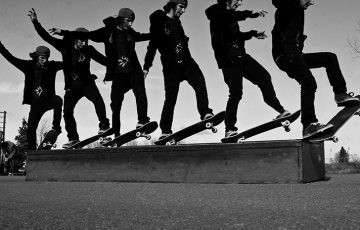The International Rugby Board Junior World Championship (IRB JWC) is the world’s most prestigious competition for international teams at the U-20 level of the game and on Friday, June 5 this tournament, comprised of sixteen of the world’s finest teams, will kick off at stadiums in Tokyo, Aichi, Osaka, Fukuoka and Saga prefectures.
Not only will this month’s tournament serve to provide the world with one of rugby’s best international spectacles of the year, with title holders New Zealand being hotly tipped to be back-to-back champions, as well as great things expected from big guns Australia, England and South Africa, it’s an extremely important litmus test for the Japan Rugby Football Union’s bid to host a future World Cup, as IRB JWC Tournament Organizer Yuichi Nakazato explains.
“This tournament is the first time for us to host such a huge global competition and it’s a great challenge for us as an organizing body as for many of the fans in Japan it will be the first opportunity for them to experience international rugby live and it will be a very different experience for them than watching university rugby and hopefully these fans will become more passionate about rugby in the future,” he says. “Also, the purpose of holding this tournament is a test of our ability to hold a World Cup rugby tournament whether in 2015 or 2019. In my opinion the possibility of Japan winning one of the bids is very high as we believe the International Rugby Board wants the sport to expand all over the world and Asia is a relatively new and sizable market, with Japan being one of the most suitable countries in terms of its infrastructure.”
The Japan Rugby Football Union is busy further developing it’s infrastructure to not only meet the demand of this month’s IRB JWC, but also to ensure that it is best placed to win its bid to host the world’s biggest international rugby event that will be watched by millions of enthusiasts from all over the globe. Five stadiums are being used for this competition, with the main stadium and home of the Japan Rugby Union being Tokyo’s Chichibunomiya Rugby Stadium (sometimes known as the Prince Chichibu Memorial Stadium—the late Prince was a devout rugby fan and a statue of him holds pride of place in the arena), which is located in the Aoyama district of Tokyo. This stadium, constructed in 1947 and affectionately dubbed ‘the field of dreams’ and ‘the spiritual home of rugby’ by players and enthusiasts, has just been transformed and upgraded to comply with the IRB’s standards and although floodlights were already installed in anticipation of night games being played in future World Cup competitions, the 25,194 seater stadium’s facelift included a brand new hospitality room, changing and shower rooms as well as a fully-functioning, ultra-modern media center.
Japan’s national U-20 squad will certainly have their work cut out for them in this month’s tournament, but an event of such gravity will pay dividends to the future stars of Japan’s World Cup squad. However, the squad is in extremely good hands under the guidance of Coaching Director Masahiro Kunda, a former coach and player of the Top League’s Toshiba Brave Lupus, as well as a nationally capped player. Kanda guided the Toshiba team to 3 championship successes in his time as their coach and has a simple slogan for his U-20 protégés and that is to quite simply: “Play with ‘The Samurai Spirit.’” Kanda is unequivocally regarded in Japanese rugby circles as one of the best if not the best coach around.
“Most U-21 national players are already involved in professional senior teams,” says Nakazato. “So the IRB changed the format of this competition to accommodate younger players. The average age of rugby players is getting lower and there’s a lot of focus from teams and unions on youth player development. In this tournament there will be many professional players representing their countries and in the squads from the top-eight rugby nations, most of the players will be pro. Take James O’Connor from the Australian team for example—at 18 years-old he was Australia’s second youngest player to receive a national cap, he’s nicknamed “The Rabbit” and will definitely be one of the young superstars to watch out for in this tournament. However Japan’s squad is comprised of mainly university students, so this tournament will be a huge challenge for the Japanese team, but this will encourage the players to grow and develop quickly,” he says.
Somewhat similar to the beginnings of the J. League the JRU’s Top League is not professional, the difference being that this was the resolve of the union, not down to a lack of interest from big-named sponsors with deep pockets. The JRU wanted to keep the sport wholesome and socially conscious and not to become tainted by commercialization like other sports in which some players have become so revered and celebrated as icons that they themselves have become bigger than the sport that created them.
“Most Top League players are still company employees,” explains Nakazato. “Essentially they are “semi-pro,” when their careers are over they return to their companies to work and many Top League players value this system and unique philosophy. When pro sports players get seriously injured or their careers end due to age, they don’t always have a fall back position. Top League players can return to work and continue to contribute to society.”
As the IRB IWC kicks off this month those in the JRU and on the World Cup bidding committee will no doubt be having a few sleepless nights. There’ll be praying the tournament is a success, the barometer for which will be the number of spectators filling the stands and all being well, with stadiums reaching capacity throughout this tournament month, this will have a positive impact on spectator support in Top League games. The icing on the cake will be the JRU getting the thumbs up to host a future Rugby World Cup—perhaps they can all rest a little easy as many insiders believe that Japan getting the green light to host the next World Cup is as good as a done deal thanks to the ongoing, tireless hard work that has and continues to go on behind the scenes in true “Samurai Spirit.”
Story by Jon Day
From J SELECT Magazine, June 2009















Recent Comments